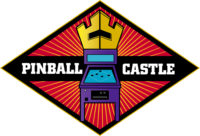As with any game, be it in the arcade or on your screen at home, it’s always interesting to take a look back at the history of pinball. Pinball has been around in some form for centuries, and so it’s worth taking a look at the history of pinball machines to understand how modern machines came to be.
The history of pinball machines goes all the way back to the 18th century, where it began in the form of games like croquet and Bagatelle. The 1900s saw the introduction of what looked more like modern pinball machines, but electronic systems weren’t added until the 1970s and 1980s.
Below, we’ll take a look at the history of pinball machines in detail, starting from its early days as Bagatelle, all the way through to the modern era with its virtual pinball machines. First, let’s go all the way back to the 1700s, to see which other games influenced the introduction of pinball.
In The Beginning
Pinball did not start out as a tabletop game or even a machine with legs. Instead, it has roots in outdoor ball games. These include croquet, golf and pallie-mallie (Pall-Mall) which is similar to crochet, but you attempt to score the ball through a hoop elevated from the ground. These games were very popular in the 1700s.
The games then evolved into a more compact version that could be played indoors. This is where we see the birth of billiards and shuffleboard. Billiards involved a long table and players used a cue to hit pins at the other side of the table, and these pins were very similar to bowling pins.
Bagatelle
As a result of players not wanting to set the pins back up after every shot, this led them to be nailed into the board instead. The ball then would “ping” off of the nails and score points from different holes. This was the introduction of the Bagatelle.
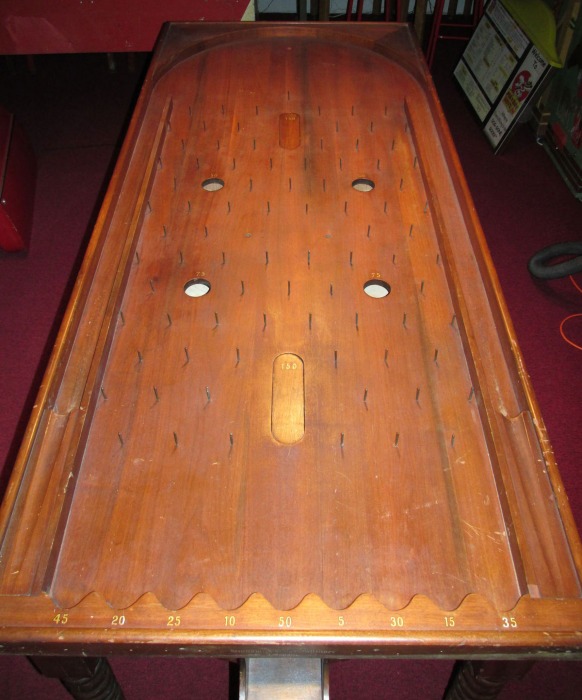
Different variations of this game had appeared around Western Europe in the 1750s-70s, some with a spring-loaded plunger. Players would shoot the ball into the field and it would bump around the table hitting pins. Different holes would win players a certain number of balls or a specific pay out. This became more of a gambling device than an arcade game, and is the direct ancestor of Pachinko.
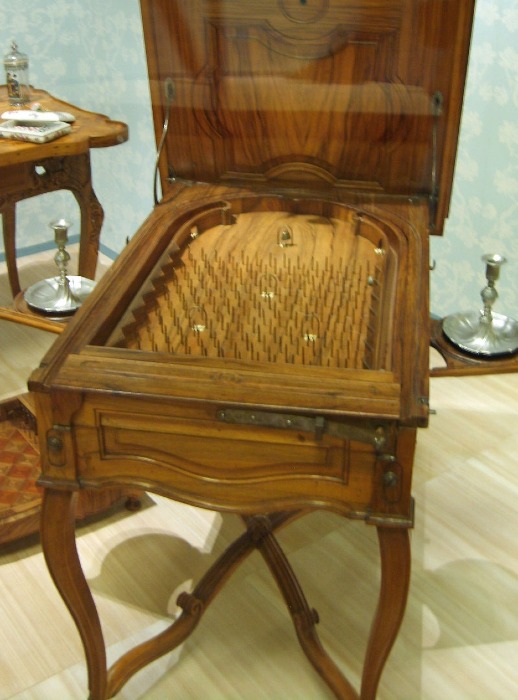
Large Games
This game became very well known throughout France. But the originals were not just countertop games, as sizes would reach around 7’ x 21”.
The game eventually spread to America through French soldiers fighting in the Revolutionary war. In 1871, Montague Redgrave received patents for improvements to this game. He standardized the spring-loaded plunger, reduced the size to fit on bar tables, replaced the balls with marbles and inclined the playfield. This would become recognized as the birth of modern pinball.
Early 1900s
With Redgrave’s advancements, these machines had become popular in households. During the great depression these games were used as a form of cheap home entertainment. The early 1930s introduced some advancements to these games called “pin games” or “marble games”. The plunger was now almost universal on all these machines.
Wiffle Board by American Industries had introduced coin operations into these games. More famously Gottlieb & Co. did the same thing on their machine the same year called Baffle Ball. Before this there were other games and casino equipment that operated on coin mechanisms to start the game, but these were the first to be seen on the pinball machines.
BallyHoo
Gottlieb’s distributor made his own game a year later called BallyHoo, and after success the company’s named changed to Bally. Around the same time, the Stern family got involved with the pinball industry as well.
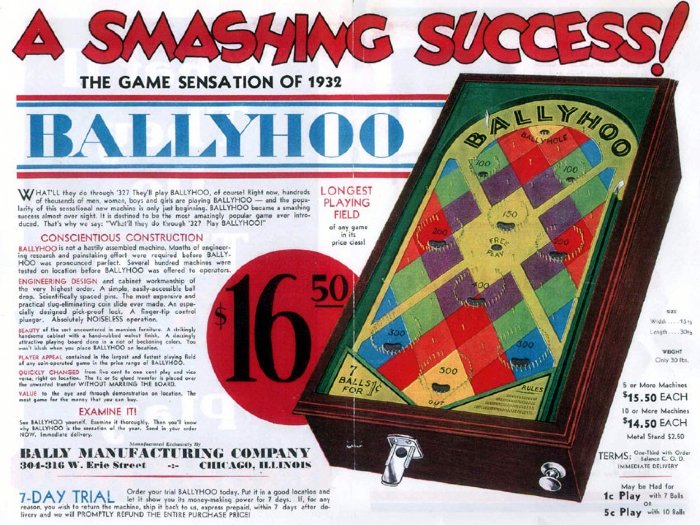
The game had holes that were the main focus for players, either scoring them points or losing their ball. The games Bolo and Bumper introduced bumpers into the game in 1933, and these games were electrified as well.
Basketball introduced very simple backglass animations in 1938, but this was still a big improvement. Competition was so heavy in the early 1930s that in 1932 there were an estimated 150 companies, but by 1934 there were only fourteen remaining.
1940s-1960s
By the end of the 1930s these machines were associated with gambling. By 1942 there were bans across the states starting in New York. America was also forced into war and this led to a major reason for these machines becoming illegal to own or manufacture. But after the war, companies went back to improving their machines and selling even more than before.
Pinball had become a shady business where you might only be able to (illegally) play in the back corner of a bar or arcade. This may have been the driving force behind Humpty Dumpty, which would be the first machine to introduce flippers. This was made by Gottlieb in 1947, and there were 6 flippers, and they were all on the outside of the playfield.
New Flippers
It wasn’t until 1950 that the flippers were placed at the bottom of the playfield as we know them to be today. At the beginning of the year Gottlieb made Just 21, but the flippers were too far apart. By October they made Spot Bowler which had flippers at the bottom, like most modern pinball machines.
Slingshots and multi-ball had been introduced to these games during this time period as well. Although multi-ball had been in games of previous decades, Balls-a-Poppin was the first multi-ball game with flippers.
In 1965 Gottlieb introduced the slingshots to allow for inlanes. These machines were considered Electro-Magnetic (EM) and ran off scoring reels. When the 1970s hit, computers were more readily available and soon the machines would be made to be much lighter.
1970s-1980s
Gottlieb created the first drop target banks in the machine called 2001. This introduced a new era for pinball machines. The first Solid State (SS) machines started to come out in the 70s, making these machines lighter and less likely to break down. This would change how scores were counted, how the displays looked and how the game was played.
Roger Sharpe
Now with computer processors to run the machine, advancements like talking machines had come alive. 1976 was a good year for pinball, as the machines were once again deemed to be legal. Roger Sharpe played a game in front of court officials proving the game was more about skill than luck. At this time people were still playing these games, but there were still laws around doing so.
Black Knight and Firepower were both released in 1980 by Williams. These machines gave way to a second level playfield, magna-save, and lane change where players could select lanes to light up.
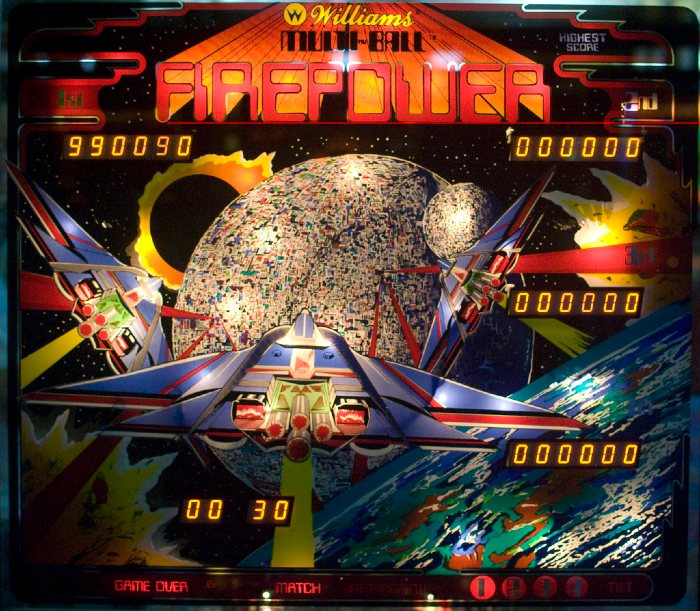
Williams machines had really broke through during this time, introducing many titles and dominating the market. Movie titles and Band licensing became popular as the titles would attract more players into the game.
But there was more torture coming in from new competitors.
Since these machines had been made available to computer chips, so did other arcade games. And these arcade games hit pinball sales pretty hard since they were new and exciting for arcade goers.
Owners of arcades liked these machines a bit more since they were easier to handle and less likely to break. Since there is no real moving part (ball) bumping around the field and instead a screen running a software, they became more in demand.
While arcade games were moving into the arcades, bars and local shops, video game consoles were heading into homes. With the rise of Atari and soon to be Sega systems, there were less people going to put quarters into pinball machines.
Golden Era 1990s
Despite the rise of arcade games and video game systems in the home, pinball survived and made a huge leap.
Dot Matrix displays were introduced by Data East Industries on the game titled Checkpoint. This advanced scoring and took animations to a new level that is a classic look today.
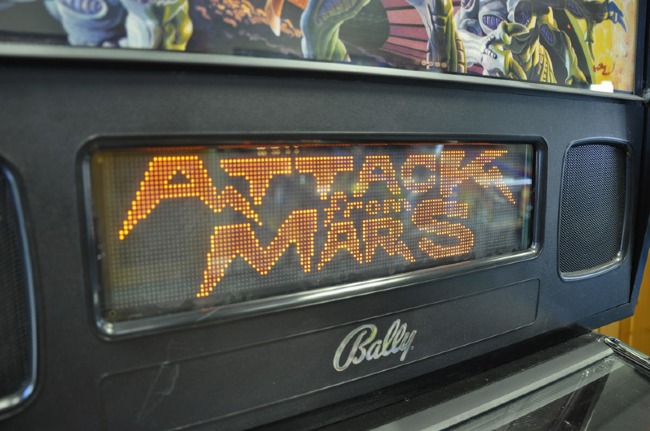
Williams machines really dominated the market during this time. Movie titles and band licensing became popular as these titles would attract more players into the game. But as these machines had made use of computer chips, other arcade games did as well. And these arcade games hit pinball sales pretty hard since they were new and exciting for arcade goers.
Software vs Hardware
Owners of arcades liked these new machines since they were easier to handle than pinball machines and less likely to break. Since there are no real moving parts (like balls) bumping around the field, and instead everything revolved around a screen running some kind of software, the demand for these other games soared.
While arcade games were moving into the arcades, bars and local shops, video game consoles were moving into homes. With the rise of Atari and then later Sega systems, there were less people going to put quarters into pinball machines.
The Golden Era Of Pinball – The 1990s
Despite the rise of arcade games and video game systems in homes, pinball survived and actually made a huge leap. Dot Matrix Displays (DMD) were introduced by Data East Industries on the game titled Checkpoint. This advanced scoring and took animations to a new level that is now a classic look today.
The best-selling pinball machine, The Addams family, was then introduced by Bally. This game had advanced playfield designs, scoring modes and even had actors from the movie record dialogue specifically from the game.
Some Of The Greats
Lots of legendary games came out during this time, including Medieval Madness, Twilight Zone, and Revenge from Mars, which was one of the most high-tech machines at the time. Attack from Mars, Monster bash, Cirqus Voltaire, Creature from the Black Lagoon, Fish Tales, Guns n’ Roses and many more greats also appeared during the 1990s.
This was the golden era of pinball, as sales were increasing, and well-known titles of movies, TV shows and bands were filling the arcade pinball section. Europe and Asia even became more interested in the game as sales to these areas were rising too. But the golden era had to come to an end, and it eventually did when the 2000s came around.
2000s – Today
Pinball had started to die out once the 2000s hit, and Stern was the last company around. They had been the last company making pinball machines until other companies started appearing. The most famous is Jersey Jack, which formed in 2013 and has released six titles.
New Kids On The Block
Jersey Jack’s machines include an LCD monitor for the backglass, allowing for vivid videos and displays. Chicago Gaming is another one that has come out with three classic title remakes. They have upgraded to LED displays for high-definition animations and more controllable settings.
Today, many people even build their own virtual pinball machines to play classic and new titles. These machines can be great for in home use and can feel pretty close to a real machine.
Final Thoughts
Pinball history has origins dating back a few hundred years, and the more modern form of pinball was introduced in the late 1800s to the early 1900s. Pinball has suffered through a recession, the great depression, war, becoming illegal and through the mass introduction of video games.
